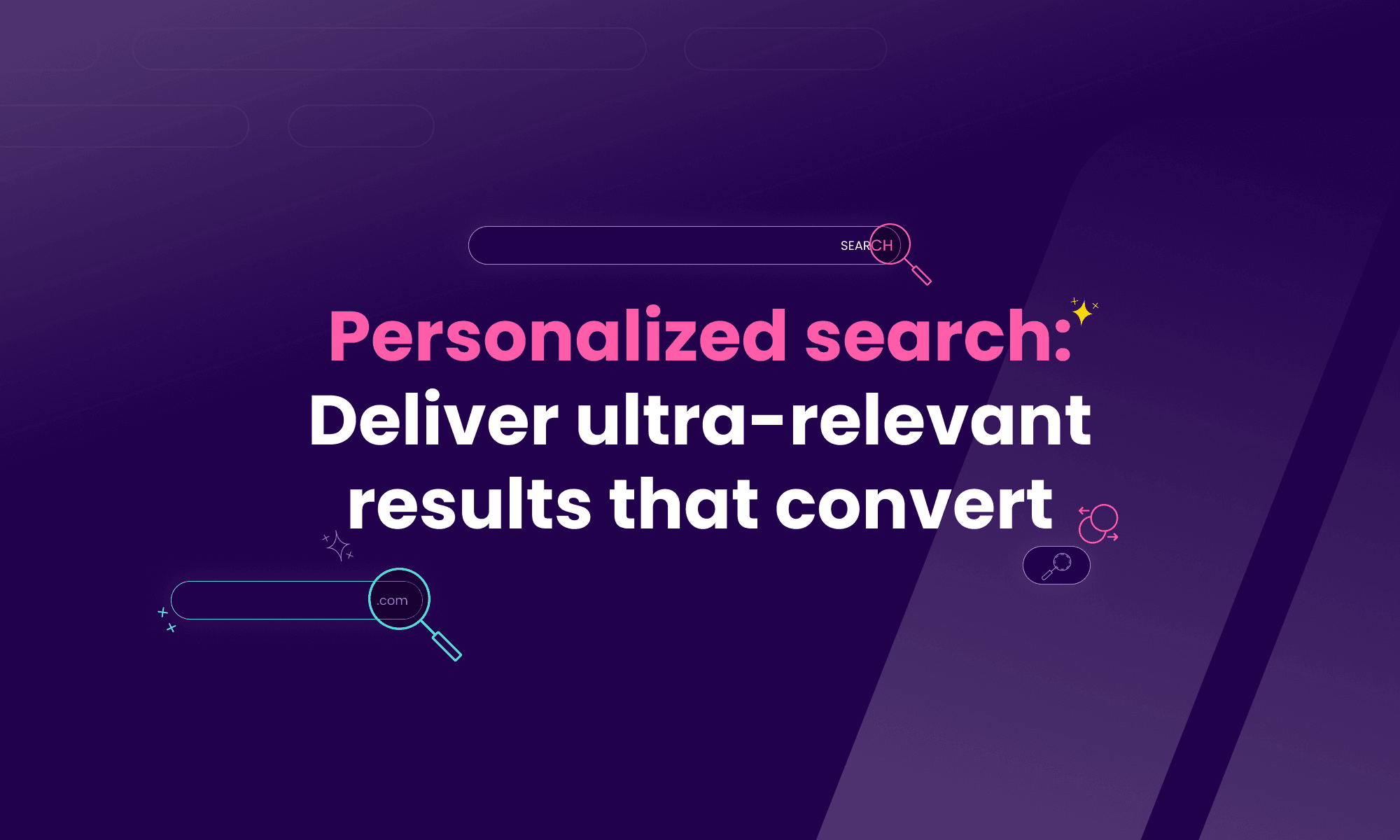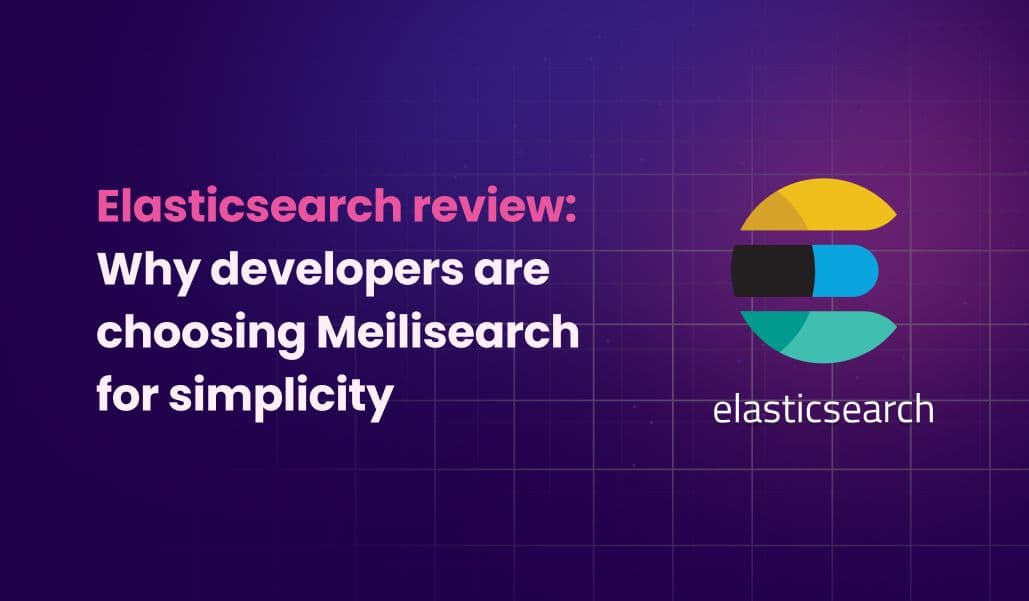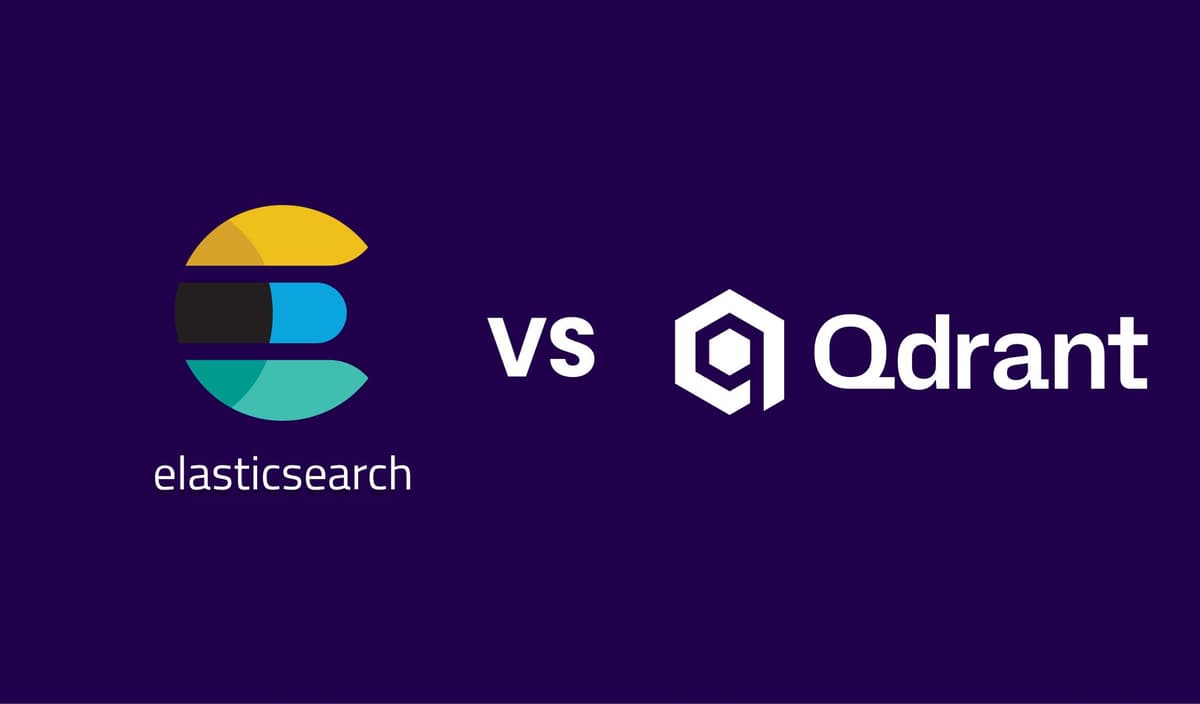Personalized search: Deliver ultra-relevant results that convert
Learn what personalized search is, how it works, its benefits and challenges, where it’s used in modern digital experiences, and more.

In this article
Personalized search is the key to keeping short-attention-span folks interested in your product or service. Users expect results that feel made for them, and personalized search is the key to meeting that expectation — and turning search into a conversion engine.
Here’s what we’ll cover:
- What personalized search means and how it’s different from traditional search.
- How it works behind the scenes: from data collection to result ranking.
- What types of data power it and why they matter.
- Benefits and challenges to consider before implementing it.
- Use cases across industries like e-commerce, streaming, and SaaS.
- Examples in action that demonstrate how personalized search is already everywhere.
- How to implement it using Meilisearch’s high-performance, developer-friendly toolkit.
What is personalized search?
As the name suggests, personalized search is when search results are tailored to the searchers based on the latter’s unique characteristics, behaviors, and preferences.
It refers to the search method where your demographics and behavior — past searches, purchases, browsing activity, location, and interests — are used to present the most relevant search results for a search query you initiate.
Unlike traditional search, which delivers the same results to everyone using the same query, personalized search relies on user data to adapt what each person sees in the results.
You’ve likely seen this in action on platforms like Netflix (suggested titles based on your viewing history), Spotify (custom playlists tailored to your listening history), or Amazon (product recommendations based on your purchasing history).
Today, delivering generic results isn’t just outdated — it’s a missed opportunity. Users expect relevance as the default.
The better you get at providing it, the more likely they are to click, buy, and stay.
How does personalized search work?
Personalized search combines behavioral insights and machine learning to make real-time changes to what users see.

Here’s a high-level look at how AI-powered personalized search works:
1. Data collection
The system gathers user-specific signals, such as search history, clicks, the pages users visit, location, and past purchases.
2. User modeling
These signals are then used to build a user profile. This user profile could be:
- Session-based (just the current visit)
- Persistent (across different sessions)
- Anonymous or authenticated
3. Query handling
Once the user submits a search query, the algorithm interprets it within the context of the user’s profile created in the previous step, adjusting the results based on perceived preferences.
4. Ranking & re-ranking
Finally, the system layers personalization on top of relevance scoring. Even if a product matches a keyword exactly, its position can shift depending on what is most relevant for that user.
Behind the scenes, features such as collaborative filtering (recommending items based on similar users’ preferences), content-based filtering (suggesting items similar to past content the user has interacted with), and hybrid models determine what rises to the top. Many systems also employ heuristics to facilitate fast decision-making and predict user needs.
Meilisearch supports these processes through its flexible API, which allows the integration of user-specific filters and vector-based recommendations without compromising on speed, even at scale.
What data is used in personalized search?
Personalized search can draw from a wide range of data signals. Some are implicit (inferred through behavior) while others are explicit (user-defined preferences).
Here are the common types of data used:
- Search history, like past searches and interactions
- Click, browse, and time-spent-on behavior
- Device type and OS
- Geolocation for localized results
- Time of day/week
- Account information (if logged in)
- Language and filter preferences
- Social signals (likes, shares, follows)
- Interaction with filters, facets, or categories
The richness of your personalization depends on the data you can ethically and transparently collect without violating user trust or data privacy regulations. This user data then informs algorithms to deliver the best results for the highest user satisfaction.
What is the difference between personalized and traditional search?
The main difference between personalized and traditional search is how results are selected and ranked.
Traditional search relies heavily — or entirely — on matching query terms with indexed content using a static algorithm. Everyone sees the same result for the same input. It’s predictable and uniform, but it's also less relevant.
Personalized search, by contrast, incorporates user data and adjusts results based on the individual user. This provides unique results and improves relevance, but adds complexity, especially around data management, compliance, and UX consistency.
Here’s a quick side-by-side comparison.

Personalized search’s reliance on user data introduces variability and complexity.
Even though it may require more setup, it also returns more value, especially in customer-facing products and services.
What are the benefits of personalized search?
Personalized search delivers measurable benefits across UX, engagement, revenue, and brand performance.
Here are the key advantages:
- Higher customer engagement: Users spend more time interacting with your site or product because of the greater relevance of search results.
- Boosted revenue: Relevant suggestions improve click-through rates and sales for most brands.
- Lower bounce rates: Users find what they’re looking for faster, so they stay on your site longer.
- Surfaced niche content: Personalization helps uncover niche or under-ranked content that users might otherwise miss.
- Improved retention and loyalty: A personalized experience builds long-term trust and brand affinity.
- Better monetization opportunities: You can highlight relevant high-margin or preferred content/products more effectively.
These benefits drive tangible business outcomes, resulting in a revenue boost of up to 40% for companies employing personalization.
What are the challenges of personalized search?
Personalized search is not without its drawbacks across user data privacy, scalability, and complexity.

Implementing personalized search involves hurdles such as:
1. Data privacy and compliance
Personalized search often relies on collecting user data, raising GDPR, CCPA, and similar concerns.
Use opt-in consent, clearly communicate the type of data collected, and anonymize or aggregate data wherever possible. Consent management should be baked into your UX from day one.
2. Cold start problem
New users or fresh content lack enough data to be included in personalization, taking search back to its traditional state.
You can overcome this by combining contextual signals (e.g., from geolocation or device) with collaborative or content-based filtering. You can also use fallback strategies like popular or trending content to give your personalized search algorithm a foundation.
3. Performance and scalability
Real-time re-ranking and personalization at scale are computationally intensive, which raises concerns about costs and scalability.
Use caching, vector databases, or edge computing to maintain speed without sacrificing relevance.
4. Over-personalization
Too much personalization can trap users in a ‘filter bubble,’ where they're only shown results they’re likely to agree with, limiting content diversity and discovery.
A good solution for this would be to blend personalized and generic results. For example, use sections like ‘For You’ and ‘Trending Now.’ You could also allow manual user adjustment for a more human-in-the-loop approach.
5. Integration complexity
Personalization involves combining multiple data sources, APIs, systems, and service layers, which can be pretty complex.
Choose modular customizable tools like Meilisearch that make it easier to implement personalization in stages for streamlined integration.
Balancing the benefits and drawbacks of personalized search will take you beyond basic search into new realms of possibility.
What are the use cases for search personalization?
Personalized search has different use cases and applications across various industries.

Some areas where personalized search shines are:
E-commerce
In e-commerce, personalized search helps users discover what they're likely to purchase. By analyzing previous purchases, browsing history, and the most frequently accessed categories or brands, marketplace search results prioritize items that match users' purchasing habits, thereby predicting their choices.
You can also include price sensitivity and availability to create more relevant, context-based product recommendations.
Media streaming
Media platforms employ personalization to display content that users are likely to enjoy, based on their viewing history, preferred genres, or browsing behavior.
For example, the platform could suggest a new period-piece series after the user completes a historical show, or optimize search results to highlight content with familiar actors or directors.
This approach reduces choice fatigue, improves user retention, and helps surface lesser-known but contextually relevant content that might otherwise be buried in extensive catalogs.
Travel booking
Travel search personalization tailors results by analyzing details from previous searches, favorite spots, airlines, hotel categories, or even loyalty programs.
For example, if you’re a frequent flyer, you might find business class options at the top of your search results. A returning user could be shown offers for destinations similar to those they’ve visited.
SaaS platforms
Personalized search in SaaS applications can prioritize the most relevant documentation, feature, or dashboard based on a user's role, past use, or recent activity.
For instance, developers might first receive content regarding API references, while analytics tools may be the most relevant content for marketers.
Such role-based tailoring speeds up onboarding, reduces support overhead, and enables users to derive value from the product sooner, thereby improving employee engagement and retention.
Online education
Learning management systems and online learning platforms use personalized search to suggest courses, modules, or learning pathways to students based on their interests, skill levels, and learning history. Whether resuming a suspended course or exploring a new subject, students can use personalization to discover relevant resources, certifications, or subsequent modules.
What is an example of personalized search?
Let’s bring personalized search use cases to life with some real-world examples.
1. ‘Pizza near me’
Let’s say you are searching for good pizza places in your location using the keyword ‘pizza near me.’
Without personalization, a system, such as a food delivery app or Google, will show all registered and available pizza places on the app.
Limited personalization may result in filtering based on a 5- or 10-mile radius around your location, such as Google’s ‘See results closer to you.’

Source: Google
With actual real-time personalization, the app will show and rank pizzerias you’ve ordered from before, that are open now, and fit your exact delivery radius.
2. Online shopping
Online marketplaces like Amazon and Trendyol aim to offer customers the widest selection of lifestyle products. First visitors will likely receive ‘random’ suggestions, perhaps only personalized to their device type or geolocation.
After a few rounds of online ‘window shopping’ or order placing, the results become more targeted, prioritizing your favorite categories, brands, preferred price range, or products you viewed last time.

Source: Trendyol
Personalization reduces friction, makes discovery intuitive, and accelerates action in every case.
But how do you get all this for your system?
Meilisearch makes it easy!
How to implement search personalization
Now that we’ve covered the ‘why’ and ‘what,’ let’s look at the ‘how.’
With Meilisearch, real-time search, relevance tuning, and fast indexing enable personalized search through features like filters, vector search, and multi-tenancy.
Here’s how to approach it:
With localized content
Personalized search with localized content uses geosearch or filters to prioritize results based on user location, language, or locale.
Meilisearch’s sorting features and geospatial search capabilities enable this.
For example, to sort correctly indexed restaurants based on their proximity to the Eiffel Tower, the following Python script for the _geoPoint sorting function may come in handy:
client.index('restaurants').search('', { 'sort': ['_geoPoint(48.8561446,2.2978204):asc', 'rating:desc'] })
For documents to be correctly sorted based on their geographic location, ensure they contain a valid _geo field.
With recent searches
Perhaps the most widely used personalization criterion is the user’s past searches. Using the user’s recent activity in the search system, the application can suggest and provide the most relevant results.
Bringing it all together: personalized search for real impact
Personalized search is no longer a ‘nice-to-have’; it’s a competitive necessity.
It transforms users' interactions with and feelings about your platform by delivering natural, effortless, and uniquely relevant search results.
The result? Higher engagement, better retention, and stronger conversion metrics.
Why Meilisearch makes personalized search more accessible
Meilisearch’s open-source nature, blazing-fast indexing performance, and developer-friendly API make implementing search personalization a breeze. Plus, native support for real-time updates allows Meilisearch to remove the technical barriers to delivering personalization at scale.


